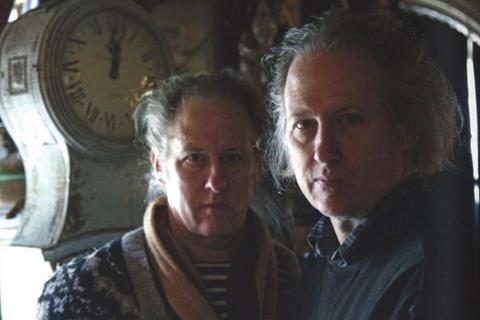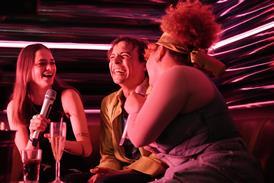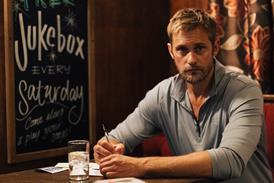
Sanatorium Under The Sign Of The Hourglass is the third feature-length film from acclaimed UK-based animator twins The Quay Brothers.
A blend of stop-motion animation and live action, it is inspired by the story collection by Polish writer Bruno Schulz, about a son Jozef, visiting his dying father in a remote Galician Sanatorium. Jozef finds the Sanatorium entirely moribund - a floating world halfway between sleep and wakefulness.
Born in 1947, The Quay Brothers’ body of work includes acclaimed short Streets Of Crocodiles (1986) and features Institute Benjamenta, or This Dream People Call Human Life (1995) and The Piano Tuner of Earthquakes (2005). They have also produced a range of other film work: puppet animation, documentaries, interludes, commercials, and installations. They have also designed decors for the theatre, opera and ballet.
Sanatorium premiered in the Giornate degli Autori section of the Venice Film Festival. It is funded by the BFI and Poland’s Telewizja Polska. The Match Factory handles international sales.

When did you start working on Sanatorium Under the Sign of the Hourglass?
Nineteen years ago. There was no budget. We just said, if we’re going to do it, we have to do it on our own. There were bursts where we spent eight or nine months doing the animation, always trying to get the BFI and anybody interested. It wasn’t until 2020 when suddenly BFI and Polish TV started to talk. And that took almost two years. In between we were doing all these other short films.
It’s a very complex, almost elusive film. How do you explain it to prospective viewers?
A son visits his dying father in the sanatorium. The sanatorium almost hypnotizes, or has this whole other world, which is sort of this maze-like. There are several fathers, several Jozefs split off, and at the end, one dies, the other one gets on the train and permanently travels on this train continuously.
It’s a canvas. What Schultz does very beautifully is this slippage of time, where corridors multiply, mazes take over. It’s this crucial element of slippage, disorientation, and things getting multiplied.
I hear you wake up at 3.30am so you can work on your animation?
You realise Aardman has something like 30 animators making a film. They go to work at, say, 9am. Each one has these little booths where they are animating. They have their own little scenario [to animate]… what’s nice for us is that we can stop at any point and build something new. When an idea occurs, we can halt the production. That’s because we get up at 3am in the morning, so we have time to do it!
And just the two of you made it?
It’s really just the two of us. We’ve always said the studio is like a laboratory to discover and invent. We do have a scenario, but they are guide points. There’s a lot of invention.
Then, of course, there’s the wild card - live action. It’s all that element of discovery, which keeps the project young, youthful and exciting, instead of just acquitting the script.
Tell us about your studio?
It’s in Old Street in London. It’s a 4x8m table. Our whole universe is created on a 4x8m table. The puppets are about 12 inches.
And how long does it take you to create?
It depends how complex [a scene is]. It could take five hours to do 10 seconds. On another day, you can do quite a lot, like a minute of animation.
Making this film over 19 years, there were 10 days of live action, 3,500 days of animation, and the audience gets to see it in 76 minutes.
Can I ask about the Polish element of it as well, and why it is in the Polish language?
We had a hunch that it would be a Polish collaboration. We always wanted it to be in Schulz’s language. Schulz is very poetic in terms of his language. It was just a challenge. We feel very at home with Schultz’s universe.
Was it hard to get funding for it?
The Poles paid for the Polish live action shoot in Warsaw. For the animation, the budget was created around paying us for those 3,500 hours! Probably a third from the Poles, two thirds BFI. The budget was just a little over a £1m.
The music plays a huge role in the film.
The musician that we credit at the front, Timothy Nelson, has been working on the film almost as long as we have. He didn’t see the images [beforehand]. He just wrote it. We always wanted music ahead, just to get a feeling for the flux of the film. We want the films to obey musical laws rather than dramaturgical laws.
When we watch a ballet, we’ve always admired that there’s no dialogue. It’s all done with gesture, rhythms, music, light, but no dialogue ever - you’re forced to make the interpretation of what’s happening on stage.
Is that what you were aiming for with Sanatorium?
Yes. There’s a framing device at the beginning with the auctioneer and the optical box with the seven visions when you liquefy the dead retina. All that sets up seven glimpses. But nobody said that there were going to be seven narrative glimpses. You do try to shape to a certain extent, but they are seven random last images that a dying retina saw.























No comments yet